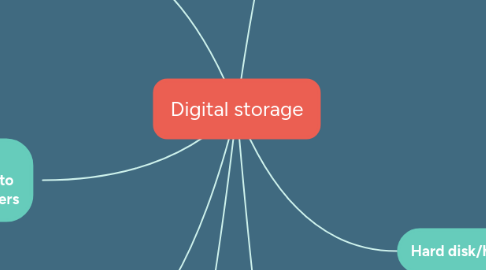
1. Portable Flash Memory Storage
1.1. Memory card- removable flash memory storage device
1.1.1. SDHC
1.1.2. SDXC
1.1.3. miniSD
1.1.4. microSDHC
1.1.5. microSDXC
1.1.6. CF
1.1.7. xD Picture card
1.1.8. Memory stick PRO Duo
1.1.9. M2
1.2. USB flash drives plug into a USB port on a computer or mobile device
2. Cloud storage- an Internet service that provides storage to computer or mobile device users
2.1. an Internet service that provides storage to computer or mobile device users
3. Optical Discs
3.1. consists of a flat, round, portable disc made of metal, plastic, and lacquer that is written and read by a laser
3.1.1. CD-ROM
3.1.2. CD-R
3.1.3. CD-RW
3.1.4. DVD-ROM
3.1.5. DVD-R or DVD+R
3.1.6. DVD-RW, DVD+RW, and DVD+RAM
3.2. commonly store items in a single track
3.3. track is divided into evenly sized sectors
4. Othe types of storage
4.1. magnetic stripe- contains information
4.2. smart card- store data on integrated circuit embedded in the card
4.3. RFID tag
4.3.1. consists of antenna and memory chip
4.3.2. contains info, transmitted via radio waves
4.3.3. RFID reader- reads signal and transfer info to computer/computing devices
4.4. NFC-enabled
4.4.1. contains NFC chip
4.4.2. NFC tag contains chip and antenna that contains info
4.4.3. most NFC tag are self-adhesive
5. Storage
5.1. Storage medium-physical material which keeps data, info, programs and apps
5.2. Storage device-hardware that records and/or retrieves items to and from storage media
5.2.1. reading- transfer data from storage medium to memory
5.2.2. writing- transfer data from memory to storage medium
5.3. Capacity-number of bytes a storage medium can hold
5.4. Volatile, contents disappeared when power removed : screen of display, most RAM
5.5. Nonvolatile, contents maintain even when power removed : contents of storage
5.6. Access time measure:
5.6.1. time taken to locate item
5.6.2. time taken to transfer item from memory to processor
6. Hard disk/hard disk drive (HDD)
6.1. use magnetic particle to store data
6.2. storage capacity determine by :
6.2.1. no of platter it contains
6.2.2. composition of magnetic coating
6.2.3. longitudinal/ perpendicular recording
6.2.4. density
6.3. formatting- dividing the disk to tracks and sectors
6.4. characteristics
6.4.1. tracks
6.4.2. sectors
6.4.3. platters
6.4.4. form factors
6.4.5. read/write head
6.4.5.1. occurs when read/write head touches the surface of platter
6.4.5.2. always keep backup of hard disk
6.4.6. revolutions per minute
6.5. Solid state drive(SSD)- flash memory that have its own processor
6.5.1. Advantages: faster access time, lighter weight, quieter operation, less power consumption
6.6. External hard disk- separate freestanding storage device that connects with a cable to a USB port or other port on a computer or mobile device
6.7. RAID (redundant array of independent disks)- group of two or more integrated hard drives
7. Enterprise storage
7.1. allows large organizations to manage and store data
7.2. for heavy use, maximum efficiency, and maximum availability
7.2.1. RAID duplicates data, instructions, and information to improve data reliability
7.3. Network attached storage (NAS)
7.3.1. server that placed on network
7.3.2. provide storage to users, computers and devices
7.4. Storage area network (SAN)
7.4.1. high-speed network
7.4.2. provide storage to other attached servers
7.5. Tape
7.5.1. magnetically coated ribbon of plastic
7.5.2. store large amount of data and info
7.5.3. tape drive reads and writes data and info on a magnetic tape
